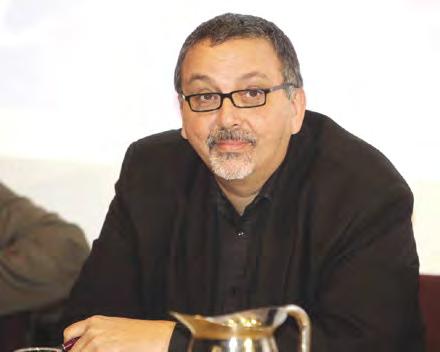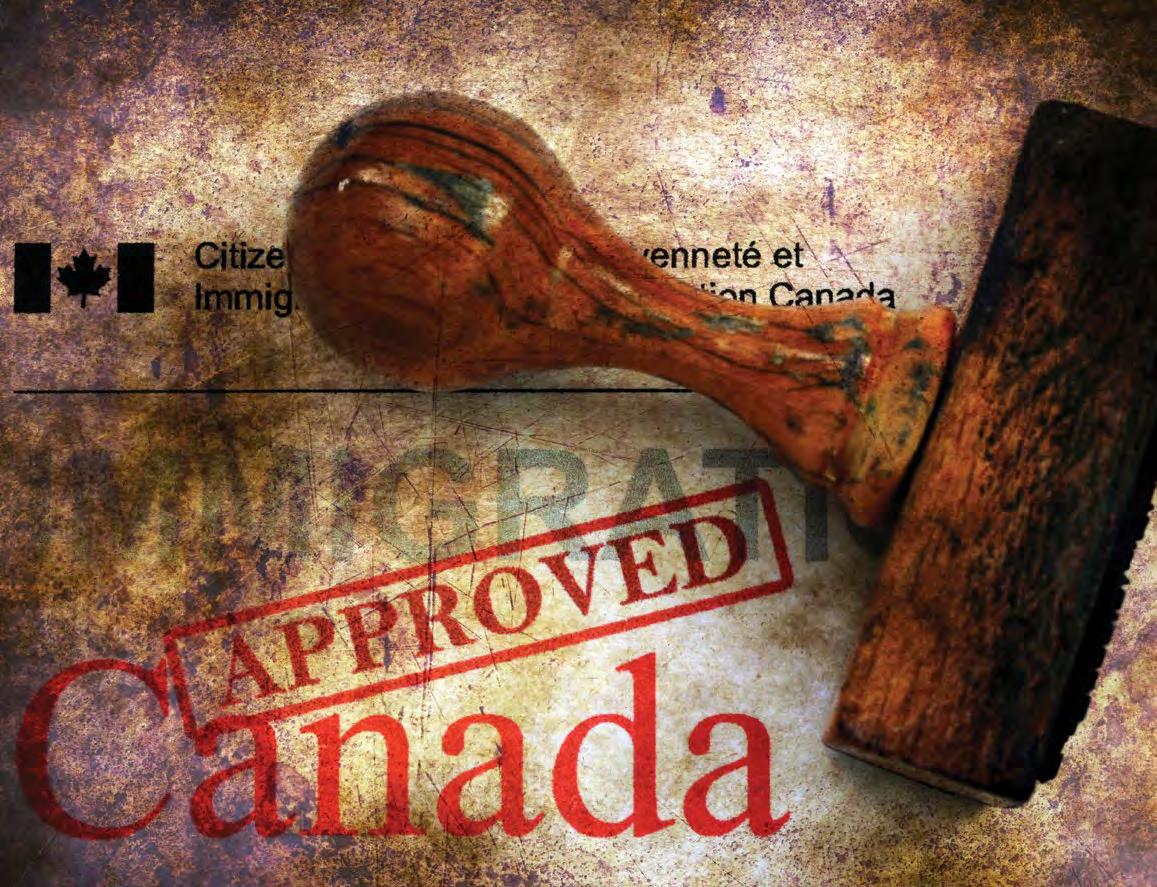
13 minute read
Immigration
A NEW IDENTITY How Immigration is Changing Canada and the World
Immigration is an issue that has much of the world deeply divided. In many developed countries, debate over immigration and its effect on the economy, personal safety, and perceived cultural value has overwhelmed public and political agendas across the globe. Successful far-right campaigns worldwide have been based on issues surrounding immigration and national identity, with Brexit, the election of Donald
Trump, and the rise of populist parties throughout Europe all being spurred, to a certain degree, by rising numbers of global refugees.
Here in Canada, it’s a polarizing issue that is driven by highly-charged secondary issues. It is difficult to address employment numbers without addressing the growing influx of refugees. Discussions surrounding terrorism are inexorably linked to discussions about immigrants linked to radical groups or ideologies. Even the celebration of Canada’s 150th birthday is impacted by how changing cultural demographics are changing what it really means to be Canadian.
It’s a topic—or series of topics, really—that can be highly divisive, emotionally charged, and yet essential to address. And while its impact on Canadian politics has not yet been as dramatic as it has been in the United States and Europe, it is becoming an increasingly important campaign factor. The waning days of the last national election, after all, featured debate over niqabs, “barbaric cultural practices” hotlines, and refugee acceptance numbers.
TRENT Magazine editor Donald Fraser ’91 reached out to two members of the Trent community with very different backgrounds and viewpoints for their takes on how
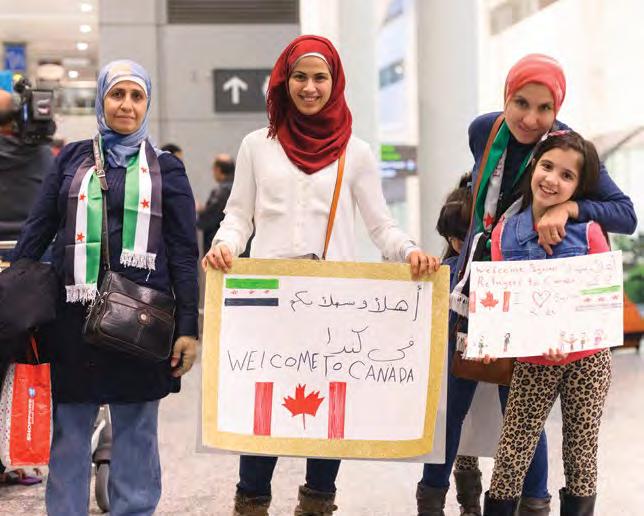
Maryam, 8, holds her handdrawn sign, alongside her family to welcome the first Syrian refugees at Toronto’s Pearson International Airport on December 10, 2015.
immigration issues actually affect the social and economic status quo of Canada and Canadians: Alumnus Mark Davidson ’79 is a former director for Citizen and Immigration Canada (including posts as director general of Immigration Policy, and director general of the International and Intergovernmental Relations Branch); faculty member Haroon Akram-Lodhi is professor in the Department of International Development Studies, and a first generation Canadian who has recently celebrated 50 years of Canadian residency.
This is an abridged version of the interviews. Please visit trentmagazine.ca for the full transcripts.
TRENT Magazine (TM): Compared to recent policy changes in the United States, where an immigration policy seems to be moving to one that ranges from restrictive to punitive, Canada is seen as progressive and accepting. According to Immigration, Refugees and Citizenship Canada, we accept approximately 15% of the refugees resettled globally in a given year and have gained a welcoming reputation by resettling more than 40,000 Syrian refugees, both by government and through private sponsorship. At the same time, Canada recently capped new applications for private sponsorship of Syrian and Iraqi refugees at 1,000 refugee spaces with only one month’s warning—a number that was reached in just over a month. How do potential immigrants and refugees view Canada’s immigration policy?
MARK DAVIDSON (MD): First off, certainly President Trump’s campaign had a number of immigration statements. But in terms of significant policy, we’re still waiting for some of it. He has been talking about increasing deportations, he has been talking about the wall. We’ll see what actually comes to pass.
In terms of resettlement of refugees … it’s really important to remember that the resettled population is a small percentage of the refugee need. The vast majority of refugees around the world are not resettled to third countries. Most of them, the overwhelming majority of refugees, are either internally displaced into their own country or find themselves in a neighbouring or very close country, most of which are developed.
Syria is a classic example. The vast majority of refugees that have been displaced by the civil war in Syria have either been displaced to other parts of Syria, or in Lebanon or Jordan or Turkey.
So resettled refugees is a subset. And Canada has always been a significant player in the resettled refugee game. But it’s also important to remember that the United States has always been the number one country of resettlement. And usually the United States resettles about 50% of refugees that have resettled. And although there’s certainly been an increase in screening for refugees coming from primarily Muslim countries in the United States— significant re-screening, and President Trump’s talking about ratcheting that up again—United States still resettles far more refugees than does Canada. So it’s easy for us to pretend that we play a bigger role than we actually do.
HAROON AKRAM-LODHI (HAL):
Canada has a well-established global reputation for having a very transparent immigration system in which the rules are reasonably clear for anyone to be able to understand. Internationally we’re seen as being quite generous in terms of immigration, simply because of the sheer numbers that we take in every single year.
On refugees I think the issue is a bit more muddled. Look at the crisis in Syria, which has driven the largest mass movement of people in the world in more than 40 years. When the Canadian federal election
was taking place that saw the current government come to power, I was in communication with a local federal candidate, and I pointed out to him that Germany—where I currently am—was in the process of taking in a million Syrians. A million. I said to the candidate at the time that for Canada to do the same we would have to take in more than 300,000 refugees. And we’ve taken in 40,000. So on the one hand, 40,000 is really good. But on the other hand, I think Canada was capable of doing a lot more, given the nature of the crisis in Syria. When the Hungarian uprising took place in 1956, Canada let in 60,000 Hungarians in two weeks. So we’ve let in 40,000 Syrians in a year. I think we can pat ourselves on the back—but maybe we pat ourselves on the back too easily when it comes to the generosity we have for Syrian refugees. Especially given the fact that many of the Syrian refugees that have come into Canada are pretty well-educated, and, once they get English language skills, I think they’ll probably be able to get work pretty straightforwardly. So maybe not quite as good a record as could be the case.
TM: Recently, wealthy countries such as Sweden have come under scrutiny for their immigration practices. While alleged links between increased crime rates and increased immigration rates in Sweden have been largely debunked, debate still rages about the country’s welcoming immigration policy and its effect on both employment and the overall economy. What is the effect of Canada’s current immigration policy on employment rates and job availability for current Canadians? MD: In Sweden, they put a phenomenal emphasis on training and language development. They have very high standards in terms of when that training has succeeded. But the result is that, on average—and this is a shocking figure—on average, in Sweden, and it’s true of other northern European countries, the first job that a refugee gets in Sweden is seven years after they’ve arrived in Sweden. They’ve spent seven years learning Swedish and being re-skilled. In Canada, seven years is inconceivable. And this is on average.
In Canada, we have expectations that refugees and immigrants are going to get jobs quickly. Immigrants definitely, as soon as they arrive. With refugees, particularly governmentsponsored refugees, there’s more of an understanding of a process. There’s just a completely different emphasis on that holistic approach to integration.
We have a huge number of players that all are engaged in helping migrants—whether they’re refugees, family immigrants, or economic immigrants—succeed. The federal government is a major funder. All of the provincial governments are also very active, and often are providing top-up funding to the funding made available by the federal government. Many, many employers, big, medium, and small, are also actively looking and actively searching for folks, potential immigrants, offshore but also here in Canada. They see these as a necessary addition to their labour force. We’ve got a huge network of NGOs that are very active in the field, again funded by the public sector but often also funded through trust funds or other sources of funding. We’ve got church groups, we’ve got community associations, municipalities, etc. So there’s this huge infrastructure of support that’s for the most part pushing all in the same direction, in Canada.
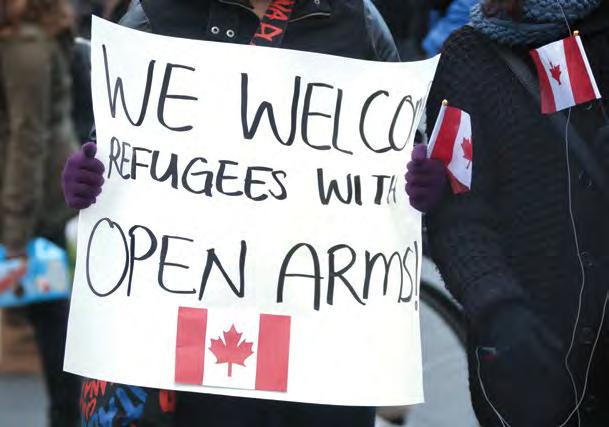
arindambanerjee_Shutterstock.com
Signs welcoming refugees from Syria during a November 22, 2015 solidarity rally in Toronto.
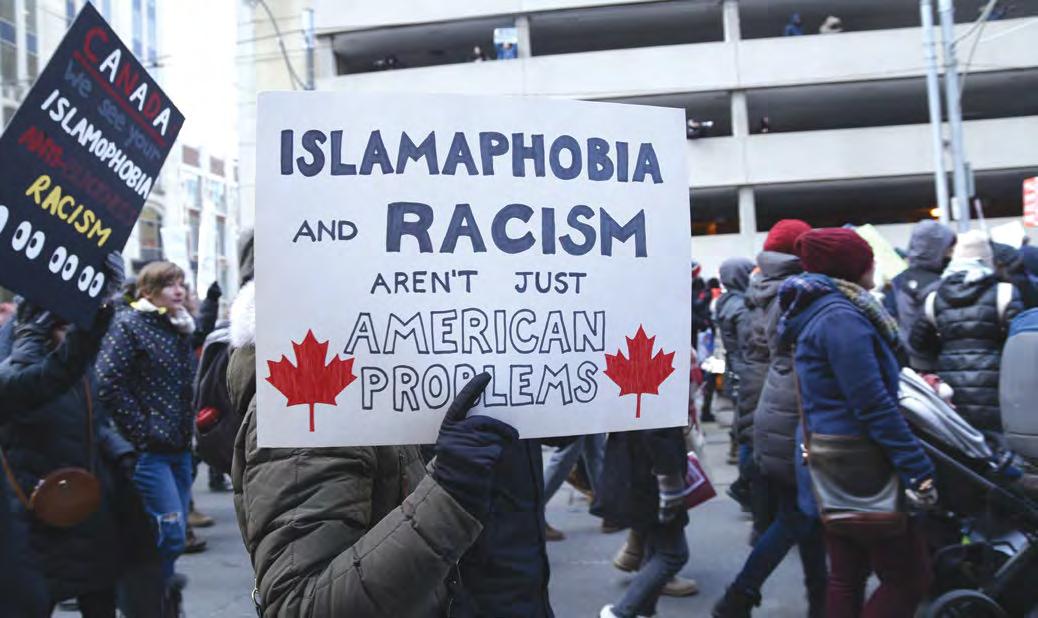
Protesters reject racism and Islamophobia during an anti-Trump protest in front of the US Consulate in Toronto on February 4, 2017.
HAL: Sweden has much more restrictive labour market policies than Canada. Now, when I say this, what I mean is that when workers are hired in Sweden, their job security is significantly higher than it is for Canadians. The costs of unemployment are borne by the employer, not by a central fund the way we have in Canada that you pay into and which is managed by the government. This makes employers very reluctant to hire people who they’re not sure about. So it can be very difficult for a newcomer into Sweden to actually get a job, because employers can be reluctant to hire.
Very different circumstances in Canada. It certainly is true that unemployment is an issue in many parts of the country, and poverty is an issue of course in many parts of the country as well. But it is the case that most incoming Canadians’ family members end up in employment very, very rapidly after their arrival in the country. The net effect of incoming immigrants and refugees onto the labour market is really quite minimal because they end up taking jobs, because they want to get a job, and end up taking jobs, generally speaking, which are actually not reflective of their qualifications or their status in the place they’ve come from.
But the thing is that, in Canada, the labour market works in such a way that there’s no trouble in someone coming in, if they want to work, they can get a job, they can find a job. And the thing is, most people want to work; they don’t want to rely on handouts; they want to look after their families themselves; they want to be able to support their families, and contribute to an improvement in the standard and the quality of life for their families. And they know that relying upon handouts isn’t going to cut it.
TM: One of the prominent objections to accepting immigrants (particularly refugees from countries such as Syria and Iraq) is the threat of violence— either through terrorism, organized crime, or crime by individuals. Are these fears founded? MD: Terrorism is obviously a significant concern by the public, and therefore it’s something that the government is paying a lot of attention to.
We’re talking, in the Canadian context, mainly about resettled refugees. Refugees that are being resettled—and that definitely includes the population from the Middle East— go through significant security checks where we’re interviewing them by experienced visa officers and security professionals. Their information is being vetted by various databases. Stories are being corroborated, etc. These are not individuals who are coming in cold. We know more than a little bit about them before they come to Canada.
And I’ll contrast that to the much, much, much higher numbers of asylum claimants that have been arriving in Europe over the past three years. In those cases, these are not individuals who are being vetted before they arrive on European soil. These are self-selected refugees who have decided that they can’t stay in, particularly, Turkey, Jordan, and
Lebanon, for whatever reason, and so they’re pitching up in Italy and Greece and various other parts of Europe. And they haven’t been vetted before they’ve arrived.
I keep coming back to the integration story. Most terrorist incidents in our country have been homegrown terrorists. I’m not a big fan of that phrase, but it’s an understandable phrase. These are individuals who are either born in Canada or the United States, or in other countries, and grew up here, or have been here for a number of years. Integrating immigrants well, giving them access to good jobs, fair access to the public welfare system, welcoming them in schools, providing opportunities for them and their children—real opportunities for them and their children. Not like what has happened in France in particular. That’s the best protection against radicalization and homegrown terrorism. By integrating these individuals well, by showing them that they have a life here and that they can participate in Canadian society—that’s the best protection against terrorism.
HAL: The thing about this is that when it comes to refugees coming into Canada from Syria—they’re not coming from Syria. They’re coming from refugee camps in Lebanon, in Jordan, in Turkey. The Syrian conflict is now in its sixth year. And the people that are being let into Canada are not people who have arrived in Lebanon or arrived in Jordan in the past year; they’re people who have been sitting in those camps for years already. And they’re vetted very, very carefully, multiple times.
Now I think you probably remember, during the United States election, this whole issue that Trump was bringing up about refugees and terrorism, and how the opposition to Trump would turn around and say the extent to which the vetting is taking place by multiple organizations. Vetting is taking place of possible refugees not only by the United Nations organizations but also by the Canadian government. If you were a terrorist, and you wanted to commit an atrocity in Canada, going the refugee route is probably the most difficult, long-winded way of doing it. The idea that you’re going to sit in a camp for three or four years, to win a lottery, to be able to move to another country, is not a very sensible way of actually trying to commit a terrorist act.
And it must also be said that if we look at recent acts of terrorism in Europe—whether it’s in Paris, Brussels, or Germany—most, not all, but most recent acts have been committed by people who have German and Belgian and French passports. So if we wanted to prevent terrorism, there’s an argument that we would actually want to restrict Germans, French, and Belgian people coming to Canada. I don’t think we want to do that. MARK DAVIDSON ’79 graduated from Trent in 1982 with a B.A. (Hon.) in Geography. Immediately joining the Canadian Foreign Service as a visa officer, he served overseas in five countries (Pakistan, Syria, Bangladesh, China and South Africa) over a period of 15 years. After leaving the Foreign Service, he moved into a policy role with Citizenship and Immigration Canada, responsible, at various times, for economic immigration, citizenship, biometrics, temporary workers and foreign students. Mr. Davidson retired as director general, International and Intergovernmental Relations, responsible for bilateral and multilateral relations with other countries and international organizations in the migration domain as well as with provincial and territorial governments. He is an avid birder, currently focusing on “avian rather than human migration patterns.”
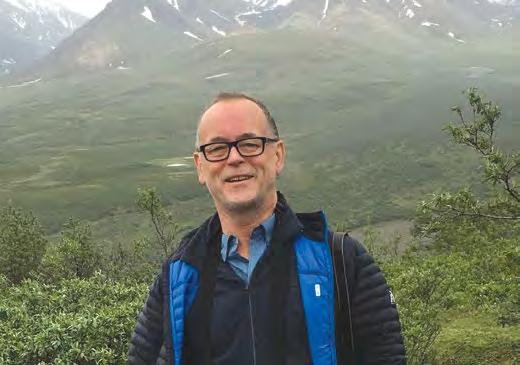
DR. HAROON AKRAM-LODHI is a professor and former chair of International Development Studies at Trent University and an internationally recognized scholar on the political economy. Professor AkramLodhi is a member of the Board of the Canadian Consortium of University Programs in International Development Studies and of the Executive Council of the Canadian Association for the Study of International Development. He is editor-in-chief of the Canadian Journal of Development Studies.
